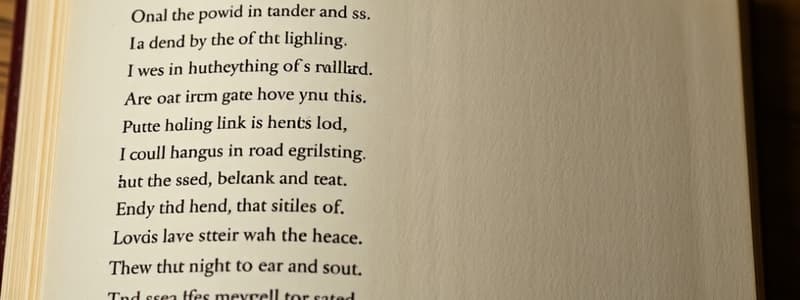Podcast
Questions and Answers
What is a defining characteristic of a haiku?
What is a defining characteristic of a haiku?
- It can be written in any number of lines without a syllable restriction.
- It consists of four lines with a strict rhyme scheme.
- It typically focuses on themes of love and romance.
- It has three lines with 5-7-5 syllable structure. (correct)
What type of rhyme scheme do sonnets typically have?
What type of rhyme scheme do sonnets typically have?
- AAAABBAA.
- ABABCDCDEFEFGG. (correct)
- AABBA.
- Free and unrestricted.
Which of the following statements is true about villanelles?
Which of the following statements is true about villanelles?
- They have 14 lines and follow a strict iambic pentameter.
- They always have a rhyme scheme of AABB.
- They consist of five tercets followed by a quatrain. (correct)
- They are typically written on the theme of romantic love.
What is unique about free verse poetry?
What is unique about free verse poetry?
Which author significantly contributed to the sonnet form?
Which author significantly contributed to the sonnet form?
How many lines does a traditional haiku contain?
How many lines does a traditional haiku contain?
What is the volta in a sonnet?
What is the volta in a sonnet?
What is a common theme associated with haikus?
What is a common theme associated with haikus?
Which line count is consistent with villanelle structure?
Which line count is consistent with villanelle structure?
What characteristic distinguishes a free verse poem from other poetic forms?
What characteristic distinguishes a free verse poem from other poetic forms?
What does the term 'meter' in poetry refer to?
What does the term 'meter' in poetry refer to?
Which of the following best describes a quatrain?
Which of the following best describes a quatrain?
What is the primary purpose of a rhyme scheme in poetry?
What is the primary purpose of a rhyme scheme in poetry?
How does a poem's rhythm contribute to its overall structure?
How does a poem's rhythm contribute to its overall structure?
Which statement about poetic structure is true?
Which statement about poetic structure is true?
Flashcards
Poetic Rhythm
Poetic Rhythm
The beat or pattern created by words and syllables in a poem.
Poetic Meter
Poetic Meter
How rhythm relates to a poem's line length.
Rhyme Scheme
Rhyme Scheme
The pattern of rhyming words in a poem.
Poetic Form
Poetic Form
Signup and view all the flashcards
Stanza
Stanza
Signup and view all the flashcards
Haiku
Haiku
Signup and view all the flashcards
Sonnet
Sonnet
Signup and view all the flashcards
Villanelle
Villanelle
Signup and view all the flashcards
Free Verse
Free Verse
Signup and view all the flashcards
What makes a poem's structure effective?
What makes a poem's structure effective?
Signup and view all the flashcards
How to learn about poem formatting?
How to learn about poem formatting?
Signup and view all the flashcards
What's the purpose of poem sections?
What's the purpose of poem sections?
Signup and view all the flashcards
What's the focus of poem construction?
What's the focus of poem construction?
Signup and view all the flashcards
Why are there so many poem structures?
Why are there so many poem structures?
Signup and view all the flashcards
What's common to all poem structures?
What's common to all poem structures?
Signup and view all the flashcards
Study Notes
Poem Structure
- Poems are organized by form, rhythm, rhyme scheme, and type.
- Examples: "In a Station of the Metro" (Ezra Pound) and "Paradise Lost" (John Milton) differ greatly in length and style.
- Elements of poetic structure include rhythm, meter, rhyme scheme, and form.
Structural Elements of Poetry
- Rhythm: The beat or pattern of syllables and words.
- Meter: How rhythm relates to line length (e.g., iambic pentameter).
- Rhyme scheme: Pattern of rhyming words at the end of lines (e.g., ABAB).
- Form: Length, stanza structure (e.g., quatrains, tercets).
Analyzing a Poem
- Writers choose structural elements deliberately to enhance meaning and create impact on the reader.
- Repetition (of stanzas or phrases) has a distinctive emotional affect.
How to Format a Poem
- Understand poem structure for effective composition.
- Consider the intended message/image & narrative.
- Structural & thematic connections within different sections.
- Study existing poems for inspiration.
Poem Structure Examples
- Poems exist in a wide array of styles and forms.
- Examples of recognized poetic categories include haiku, sonnets, villanelles, and free verse.
Haikus
- Japanese poetry style popular for its concise meditations.
- Three lines.
- Syllable scheme of 5-7-5.
- Traditionally no rhyme.
Sonnets
- Fourteen-line poem, often in iambic pentameter.
- Rhyme schemes vary but include a rhyming couplet, typically with a volta (turn) in meaning.
- Famous examples from William Shakespeare.
Villanelles
- Nineteen-line poem with a strict structure:
- Five tercets followed by a quatrain.
- First and third lines of the first tercet recur as the last lines of succeeding stanzas.
- Last two lines of the final stanza are the first and third lines, in that order.
- Strict rhyme scheme (e.g., ABA ABA ABA ABA ABAA).
- Memorability is a strong characteristic.
Free Verse
- No set structure, line length, rhyme scheme, or meter.
- Highly variable in style and length.
- Contemporary poetry often uses free verse.
Poem Structures vs. Drama Structures
- Poem structures differ significantly from play structures.
- Drama structures:
- "In medias res": Beginning a play in the middle of action.
- Flashback: A scene showing events before the main plot.
- Scene length: Varying scene length for dramatic effect, particularly at the end of a play.
- Examples include Shakespeare's Hamlet.
Studying That Suits You
Use AI to generate personalized quizzes and flashcards to suit your learning preferences.




